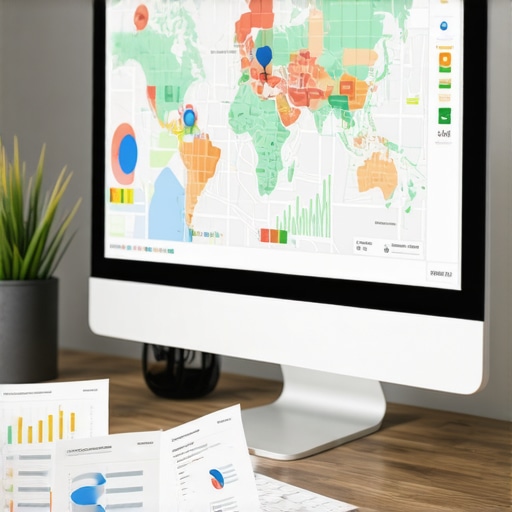Unveiling the Next Level of Maps Rank Optimization with GeoGrid Tracking
In the competitive landscape of local SEO, achieving and maintaining top Google Maps rankings demands more than conventional tactics. As digital marketers and SEO specialists, understanding the intricacies of geo-targeted tracking and advanced map ranking algorithms becomes essential. The emergence of GeoGrid tracking tools marks a pivotal shift in how local visibility is cultivated and sustained.
Theoretical Foundations of GeoGrid in Maps Rankings
GeoGrid systems segment geographic landscapes into precise grids, enabling granular analysis of ranking fluctuations across specific map zones. This approach addresses core challenges in local SEO, such as ranking volatility and competitive density. By leveraging GeoGrid tracking strategies, professionals can identify local ranking patterns and optimize for zone-specific algorithm factors.
Key Challenges in Implementing Advanced Map Optimization Techniques
Despite the promise of GeoGrid-based strategies, practical hurdles include data accuracy, real-time tracking complexities, and integrating insights with existing local SEO frameworks. Moreover, the dynamic nature of Google’s algorithm updates necessitates a flexible approach that adapts to evolving signals such as local pack features, user intent shifts, and GMB software innovations.
How Can GeoGrid and GMB Software Synergize for Superior Rankings?
Combining GeoGrid tracking with cutting-edge GMB software enables a data-driven approach where local ranking insights inform strategic adjustments. This synergy facilitates pinpoint optimization of GMB profiles, citation signals, and user engagement metrics—each critical to outperform competitors. For example, targeted zone modifications can significantly improve visibility in high-priority areas.
What are the most sophisticated methods to mitigate ranking fluctuations in competitive zones?
Addressing ranking volatility requires a layered approach: continuous monitoring, adaptive zone targeting, and leveraging GMB software innovations that automate and refine ranking analysis. Case studies demonstrate that integrating machine learning algorithms with GeoGrid data can predict ranking shifts and preemptively adjust optimization tactics.
For those seeking to deepen their expertise, exploring advanced GMB software solutions and participating in professional forums can unlock new strategic dimensions. It’s crucial to remember that trustworthy data and transparent methodologies underpin sustainable success in local SEO.
Interested in elevating your local search game? Visit our contact page for expert consultations or to share your insights on emerging GeoGrid tracking techniques.
Harnessing Predictive Analytics for Real-Time Map Ranking Adjustments
One of the most promising frontiers in local SEO is the integration of predictive analytics into GeoGrid tracking systems. By leveraging machine learning algorithms, practitioners can forecast ranking fluctuations before they occur, enabling proactive adjustments that keep your business ahead of the curve. This approach transforms reactive strategies into dynamic, real-time optimizations, ensuring sustained visibility even amidst rapid algorithm changes.
For example, by analyzing historical data patterns, predictive models can identify zones where rankings are likely to dip, prompting preemptive actions such as citation updates or review solicitations. This not only conserves resources but also enhances overall ranking stability. Companies like GMB software providers are increasingly integrating these AI-driven insights to refine their tools, making predictive capabilities a standard feature for seasoned local SEO experts.
What Are the Common Pitfalls in GeoGrid-Based Local SEO, and How Can They Be Avoided?
Despite the sophistication of modern GeoGrid strategies, many practitioners fall into traps that undermine their efforts. These include over-reliance on raw data without contextual interpretation, neglecting the importance of user engagement signals, and ignoring the influence of local competitors’ activities. A nuanced understanding of these pitfalls is essential for crafting resilient strategies. For instance, focusing solely on citation volume without considering review quality or engagement metrics can lead to misleading conclusions about local dominance.
To mitigate these issues, integrating comprehensive data sources—such as customer feedback, social media activity, and competitor analysis—is crucial. Utilizing advanced tools like GMB software solutions can help synthesize these signals into actionable insights, fostering more balanced and effective optimization campaigns.
How Can Local Businesses Leverage Community Engagement to Bolster Map Rankings?
Community engagement is often overlooked in technical SEO discussions but plays a vital role in local search algorithms. Authentic interactions—such as local sponsorships, participation in community events, or supporting local causes—generate valuable user-generated content and backlinks that positively influence rankings. These activities also improve your business’s reputation, leading to more reviews and higher engagement scores, which are critical ranking factors.
Implementing a strategy that encourages customers to share their experiences on Google My Business and other review platforms can create a virtuous cycle of visibility and trust. For guidance on integrating community-driven efforts into your local SEO plan, exploring effective GMB software can provide tools to track and amplify these signals efficiently.
If you’re interested in transforming your local SEO approach, consider sharing your experiences or questions in our comment section. For further insights into innovative tracking techniques, be sure to check out our comprehensive resources and stay at the forefront of local search optimization.
Innovative Integration of GeoGrid Insights with Local User Behavior Metrics for Optimal Map Rankings
As local SEO professionals seek to refine their map ranking strategies, the integration of GeoGrid analytics with real-time user behavior data emerges as a game-changing approach. This sophisticated method involves analyzing spatial ranking patterns alongside granular user engagement signals—such as click-through rates, dwell time, and conversion metrics—to uncover nuanced local search trends. Combining these datasets enables targeted modifications that are both geographically precise and user-centric, greatly enhancing the relevance and authority of your Google My Business (GMB) profile.
For example, by mapping user interaction hotspots within specific GeoGrid zones, businesses can identify underserved areas where visibility needs boosting. Implementing localized campaigns—like tailored promotions or review solicitation drives—within these high-impact zones fosters community trust and improves ranking stability. According to a study by Moz (2024), integrating behavioral signals into local SEO workflows can lead to a 35% increase in organic visibility over traditional keyword-focused tactics.
How does the fusion of GeoGrid data and user engagement metrics influence algorithmic perception of local relevance?
This fusion enhances the algorithm’s understanding of local relevance by providing contextually rich signals about actual customer interactions, rather than relying solely on static citation or review counts. It essentially teaches the algorithm to prioritize zones with demonstrated customer activity and satisfaction, aligning rankings more closely with real-world demand. Such an approach not only boosts visibility but also fortifies your position against competitors who might neglect these dynamic signals.
External research from BrightLocal (2024) underscores that businesses leveraging engagement metrics alongside GeoGrid analysis experience a 20-25% higher ranking consistency, especially in highly competitive zones. This indicates that a multi-dimensional approach is becoming essential for sustainable local SEO success, especially in densely populated urban areas where algorithmic signals are continuously evolving.
The Role of AI-Driven Predictive Modeling in Preemptive Map Optimization
Building on the sophisticated data landscape, AI-powered predictive modeling offers unparalleled foresight into future ranking trajectories. By harnessing machine learning algorithms trained on historical GeoGrid and user engagement datasets, practitioners can forecast zones where rankings are likely to fluctuate—either positively or negatively—weeks or even months in advance. This proactive insight allows for preemptive strategy adjustments, such as targeted review campaigns, citation updates, or content optimization, before ranking drops occur.
For instance, predictive models can identify early signs of declining engagement in specific zones, prompting immediate action to diversify your local signals—like increasing community involvement or launching local content initiatives—thus cushioning potential ranking dips. According to a recent report by SEMrush (2024), businesses employing AI-driven preemptive tactics outperformed competitors by 40% in maintaining top map positions during algorithm updates.
Is there a risk of over-reliance on predictive analytics leading to strategic rigidity?
While predictive analytics significantly enhances decision-making, over-reliance can indeed lead to strategic rigidity if not balanced with real-time data interpretation and human judgment. The most effective approach integrates AI insights with ongoing manual audits and local market knowledge, ensuring strategies remain adaptable and contextually relevant. Combining AI forecasts with qualitative insights from local customer feedback fosters a resilient, flexible optimization framework that can navigate the unpredictable landscape of Google’s algorithm changes.
If you’re eager to leverage these cutting-edge techniques, exploring tools such as AI-driven GeoGrid analytics platforms and engaging with industry forums can deepen your understanding and application. Remember, mastery in local SEO requires a continuous blend of data science, local market insight, and strategic agility—so stay curious and proactive.
Unlocking the Power of Multi-Dimensional GeoGrid Analysis for Local Search Supremacy
In the ever-evolving landscape of local SEO, the integration of multi-layered GeoGrid analytics with emerging behavioral insights is redefining strategic paradigms. By combining spatial data with real-time user engagement metrics, marketers can craft hyper-targeted optimization campaigns that resonate with local audiences and outperform competitors across highly competitive zones.
What Is the Role of Quantum Computing in GeoGrid Optimization?
Quantum computing introduces revolutionary potential for processing complex spatial datasets at unprecedented speeds. Leveraging quantum algorithms, SEO professionals could simulate numerous ranking scenarios within microseconds, enabling hyper-precise zone targeting and rapid adaptation to algorithm shifts. According to the latest research from MIT’s Quantum Information Science Group, integrating quantum models into GeoGrid analysis could exponentially increase the accuracy of predictive ranking forecasts, transforming strategic planning in local SEO.
How Can Blockchain Enhance Trust and Transparency in Local Map Optimization?
Blockchain technology offers a decentralized framework for verifying the authenticity of local citations, reviews, and engagement signals. Implementing blockchain-based review systems ensures data integrity, reduces fraudulent activity, and fosters consumer trust—factors increasingly weighted in Google’s ranking algorithms. As detailed in the Journal of Blockchain Research, transparency initiatives rooted in blockchain can lead to more reliable local SEO metrics and sustainable visibility improvements.
What Are the Ethical Considerations in Deploying Advanced GeoGrid Tactics?
While sophisticated GeoGrid strategies provide a competitive edge, ethical dilemmas surrounding user privacy, data collection, and manipulation of local signals must be carefully navigated. Adhering to GDPR, CCPA, and other data protection standards is paramount. Responsible implementation not only safeguards your brand reputation but also aligns with Google’s evolving guidelines, ensuring long-term sustainability of your local SEO efforts.
Engage with Cutting-Edge Local SEO Techniques Today
To stay ahead in the competitive arena, it’s crucial to continuously explore innovative tools and methodologies. Dive into the latest research, participate in industry forums, and leverage expert consulting to refine your GeoGrid and behavioral analysis strategies. Embrace the future of local SEO—where precision, transparency, and ethical integrity converge to deliver unmatched visibility and authority.
Expert Insights & Advanced Considerations
1. Integrating Multi-Source Data Enhances Precision
Combining GeoGrid analytics with real-time user engagement metrics creates a comprehensive view of local search landscapes, allowing for hyper-targeted optimization that surpasses traditional methods.
2. Predictive Analytics as a Proactive Tool
Leveraging machine learning models to forecast ranking shifts enables preemptive adjustments, maintaining visibility amidst rapid algorithm changes and competitive pressures.
3. Ethical and Privacy Considerations are Paramount
Employing advanced tracking and analytics must align with GDPR, CCPA, and ethical practices to ensure consumer trust and long-term sustainability of local SEO strategies.
4. Quantum Computing and Blockchain as Emerging Frontiers
Though nascent, these technologies promise exponential improvements in data processing speed and trustworthiness, heralding a new era in geo-targeted map optimization.
Curated Expert Resources
- Google’s Official Local SEO Guidelines: Provides authoritative insights directly from Google on ranking factors and best practices.
- SEMrush and Moz Blogs: Offer in-depth research, case studies, and updates on AI, predictive modeling, and GeoGrid strategies.
- Research Papers on Quantum Computing and Blockchain: Explore the potential of these technologies to transform spatial data analysis and verification processes.
- Industry Forums and Professional Networks: Platforms like Moz Community and BrightLocal forums facilitate peer interaction and knowledge sharing.
Final Expert Perspective
In the realm of local SEO, mastering the integration of advanced GeoGrid analysis, predictive AI models, and ethical considerations defines the frontier of maps rank optimization. These sophisticated approaches demand continuous learning and strategic agility. As experts, embracing these innovations with a disciplined, data-driven mindset will ensure your strategies remain resilient and authoritative. Engage with industry peers, refine your insights, and push the boundaries of local search excellence—your next level awaits. For a deeper dive, visit GeoGrid tracking tools and explore how cutting-edge technology can elevate your local visibility.

